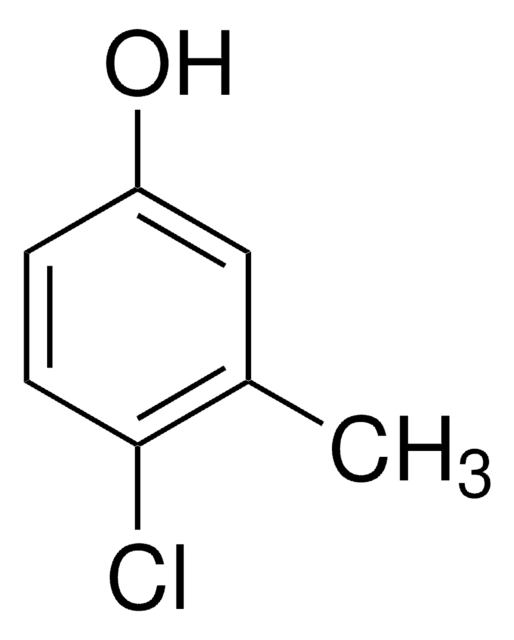24940
4-Chlor-3-methylphenol
≥98.0% (HPLC)
Synonym(e):
4-Chlor-m-kresol, PCMC
About This Item
Empfohlene Produkte
Assay
≥98.0% (HPLC)
Form
pellets
bp
235 °C (lit.)
mp (Schmelzpunkt)
63-65 °C (lit.)
Löslichkeit
methanol: soluble 1 g/10 mL, clear, colorless
water: soluble
SMILES String
Cc1cc(O)ccc1Cl
InChI
1S/C7H7ClO/c1-5-4-6(9)2-3-7(5)8/h2-4,9H,1H3
InChIKey
CFKMVGJGLGKFKI-UHFFFAOYSA-N
Suchen Sie nach ähnlichen Produkten? Aufrufen Leitfaden zum Produktvergleich
Allgemeine Beschreibung
Anwendung
Signalwort
Danger
H-Sätze
Gefahreneinstufungen
Acute Tox. 4 Oral - Aquatic Acute 1 - Aquatic Chronic 3 - Eye Dam. 1 - Skin Corr. 1C - Skin Sens. 1B - STOT SE 3
Zielorgane
Respiratory system
Lagerklassenschlüssel
6.1A - Combustible acute toxic Cat. 1 and 2 / very toxic hazardous materials
WGK
WGK 2
Flammpunkt (°F)
244.4 °F - closed cup
Flammpunkt (°C)
118.0 °C - closed cup
Persönliche Schutzausrüstung
dust mask type N95 (US), Eyeshields, Faceshields, Gloves
Analysenzertifikate (COA)
Suchen Sie nach Analysenzertifikate (COA), indem Sie die Lot-/Chargennummer des Produkts eingeben. Lot- und Chargennummern sind auf dem Produktetikett hinter den Wörtern ‘Lot’ oder ‘Batch’ (Lot oder Charge) zu finden.
Besitzen Sie dieses Produkt bereits?
In der Dokumentenbibliothek finden Sie die Dokumentation zu den Produkten, die Sie kürzlich erworben haben.
Unser Team von Wissenschaftlern verfügt über Erfahrung in allen Forschungsbereichen einschließlich Life Science, Materialwissenschaften, chemischer Synthese, Chromatographie, Analytik und vielen mehr..
Setzen Sie sich mit dem technischen Dienst in Verbindung.







